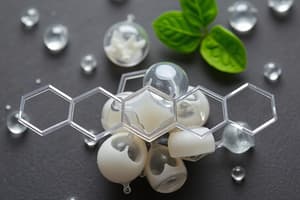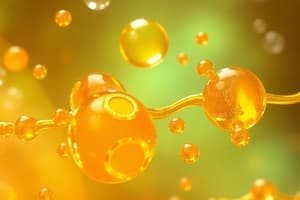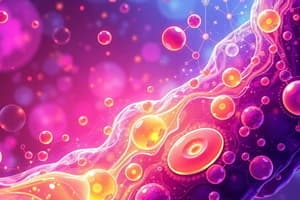Podcast
Questions and Answers
What characteristic defines saturated fats?
What characteristic defines saturated fats?
- Contain multiple double bonds
- Are typically liquid at room temperature
- Lack double bonds in their fatty acid chains (correct)
- Have a branched chain structure
Which of the following fatty acids is a polyunsaturated fat?
Which of the following fatty acids is a polyunsaturated fat?
- Linoleic acid (correct)
- Butyric acid
- Palmitic acid
- Stearic acid
What dietary components are most strongly associated with high levels of total plasma cholesterol?
What dietary components are most strongly associated with high levels of total plasma cholesterol?
- Polyunsaturated fats
- Omega-3 fatty acids
- Monounsaturated fats
- Saturated fats (correct)
What is a primary source of monounsaturated fatty acids?
What is a primary source of monounsaturated fatty acids?
Which statement about unsaturated fats is true?
Which statement about unsaturated fats is true?
Which of the following is NOT a function of lipids?
Which of the following is NOT a function of lipids?
What distinguishes unsaturated fatty acids from saturated fatty acids?
What distinguishes unsaturated fatty acids from saturated fatty acids?
Which type of lipid is known for being liquid at room temperature?
Which type of lipid is known for being liquid at room temperature?
What is the primary storage form of lipids in the human body?
What is the primary storage form of lipids in the human body?
Which of the following fatty acids is classified as monounsaturated?
Which of the following fatty acids is classified as monounsaturated?
Flashcards
Saturated Fats
Saturated Fats
Saturated fats have no double bonds in their fatty acid chains. They are typically solid at room temperature and found in animal fats and some vegetable oils.
Unsaturated Fats
Unsaturated Fats
Unsaturated fats have one or more double bonds in their fatty acid chains. They are usually liquid at room temperature and can be healthful.
Monounsaturated Fats
Monounsaturated Fats
Monounsaturated fats contain only one double bond and are typically derived from plant sources.
Polyunsaturated Fats
Polyunsaturated Fats
Signup and view all the flashcards
Linolenic Acid
Linolenic Acid
Signup and view all the flashcards
Arachidonic Acid
Arachidonic Acid
Signup and view all the flashcards
Cardiovascular Disease Risk
Cardiovascular Disease Risk
Signup and view all the flashcards
Healthier Fats
Healthier Fats
Signup and view all the flashcards
Lipids
Lipids
Signup and view all the flashcards
Functions of Lipids
Functions of Lipids
Signup and view all the flashcards
Simple Lipids
Simple Lipids
Signup and view all the flashcards
Triacylglycerol (TAG)
Triacylglycerol (TAG)
Signup and view all the flashcards
Fatty Acid
Fatty Acid
Signup and view all the flashcards
Saturated Fatty Acid
Saturated Fatty Acid
Signup and view all the flashcards
Unsaturated Fatty Acid
Unsaturated Fatty Acid
Signup and view all the flashcards
Energy Storage (Lipids)
Energy Storage (Lipids)
Signup and view all the flashcards
Lipid Classification
Lipid Classification
Signup and view all the flashcards
Study Notes
Lipid Nutritional Biochemistry
- Lipids are organic compounds containing carbon, hydrogen, and oxygen (C, H, O).
- They are insoluble in water, but soluble in fat solvents like ether, alcohol, benzene, and chloroform.
- Lipids are not polymers; they are not formed from repeating units like polysaccharides.
Functions of Lipids
- Efficient energy sources
- Thermal insulators
- Component of cell membranes
- Involved in steroid hormone synthesis
- Crucial for the absorption and digestion of fat-soluble vitamins (A, D, E, K).
Classification of Lipids
- Simple Lipids: Neutral fats (e.g., fats and oils) and waxes
- Compound Lipids: Phospholipids, glycolipids, and lipoproteins
- Derived Lipids: Fatty acids, alcohols, and sterols
Simple Lipids
- Neutral fats: Esters of fatty acids and glycerol.
- Liquid at room temperature: Oils
- Solid at room temperature: Fats
- Also known as Triglycerides (TAG)
Fatty Acids
- Saturated: No double bonds
- Unsaturated: Contain double bonds
- Monounsaturated: One double bond
- Polyunsaturated: Two or more double bonds
- Examples: Stearic acid, oleic acid, linoleic acid, linolenic acid, arachidonic acid
- Important for cell membrane structure and function
Phospholipids
- Major component of cell membranes
- Structure: 2 fatty acids + phosphate head
- Fatty acid chains are hydrophobic; phosphate head is hydrophilic
Lipoproteins
- Transport lipids in the bloodstream
- Different types (e.g., VLDL, LDL, HDL) with varying lipid and protein composition
- Important role in cardiovascular health
Waxes
- Solid at room temperature
- Insoluble in water
- Protective covering for animals and plants (e.g., beeswax, earwax, cuticle of leaves)
Biological Functions of Lipids
- Energy Storage: Provide high energy (9 kcals/gram), stored as adipose tissue, comprising 60% of body energy
- Insulation & Protection: For thermal protection, insulation and protection of organs
- Health Effects: Excess fat intake can lead to diseases like obesity, diabetes, and cancer.
Dietary Recommendations
- Limit total fat intake to <30% of total calories.
- Limit cholesterol intake to <300 mg/day.
- Limit saturated and polyunsaturated fats to <10% of total calories each.
Studying That Suits You
Use AI to generate personalized quizzes and flashcards to suit your learning preferences.




